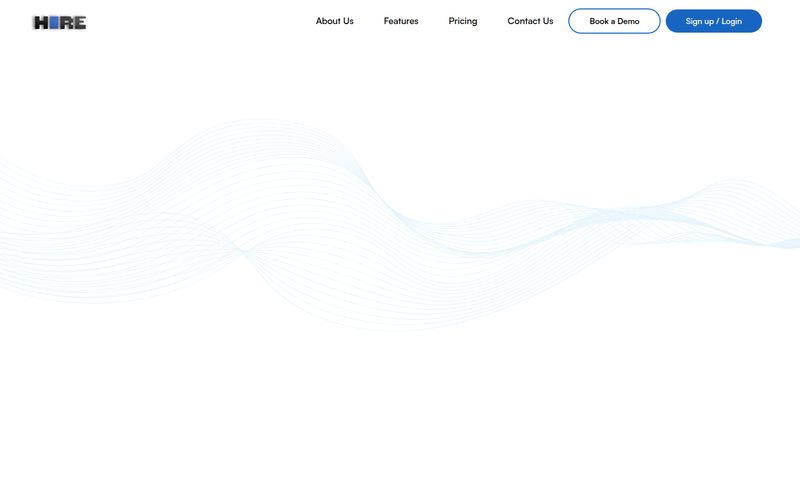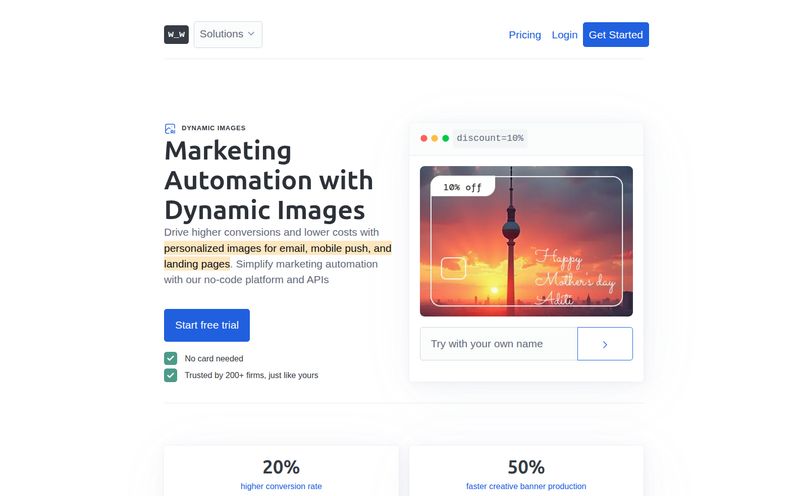If you're a content creator, you've probably had that sinking feeling. You finish a brilliant video script, or a killer podcast outline, and then you remember… you have to record the audio. For many of us, the sound of our own voice is pure cringe. For others, hiring a voice actor for every project just isn’t in the budget. And the task of transcribing hours of audio? A special kind of digital torture.
I’ve been in that boat more times than I can count. I've spent ages trying to find the perfect AI voice tool, wading through a sea of robotic, soulless options that sound like a GPS navigator from 2005. So when I stumbled upon Voiser, which claims to offer natural-sounding voices and accurate transcription, my professional curiosity was piqued. But was it just another drop in the ocean? I decided to sign up and find out.
So, What Exactly Is This Voiser Thing?
At its core, Voiser is an AI-powered platform built on two main pillars: turning your text into speech (TTS) and turning your speech into text (STT). Think of it as a digital voice box and a hyper-efficient stenographer all rolled into one. The big claim to fame is its support for over 75 languages and a library of different voices, which immediately sets it apart from a lot of the competition.
It's clearly built for people who make stuff – podcasters, YouTubers, marketers, e-learning instructors, and businesses that need audio content without the hassle and cost of a full recording studio. The platform promises not just conversion, but high-quality conversion. That’s always the million-dollar question, isn't it?

Visit Voiser
First Impressions: Signing Up and Kicking the Tires
Getting started was refreshingly simple. The usual suspects for sign-up are there: Google, Facebook, or plain old email. The dashboard is clean, and you’re immediately presented with the two main options: ‘Seslendirme’ (Text-to-Speech) and ‘Deşifre’ (Speech-to-Text). Even though the screenshots I saw were in Turkish, the layout is so intuitive you could probably navigate it with your eyes closed. It's a good sign when a tool doesn't make you hunt for its main features.
I also noticed a little prompt about a referral code for a discount. It’s a small thing, but it shows a focus on growth and community, which I always appreciate. It feels less corporate and more like they want people to actually use and share their tool.
The Main Attraction: Creating Voiceovers with Text-to-Speech
This is where most people will either fall in love or walk away. I've heard my share of AI voices, and frankly, most of them are… bad. They're flat, they mispronounce words, and they have the emotional range of a brick. Voiser, I’m happy to report, is a different beast.
The Sound of Voiser's AI Voices
The voices are genuinely impressive. They're not perfectly human—you can still tell it’s an AI if you listen closely—but they've crossed a critical threshold. They have inflection. They pause in the right places. They don't sound like a robot reading a phone book at gunpoint. It's more like having a very patient, slightly-too-perfect intern read your script for you. For YouTube videos, corporate explainers, or e-learning modules, the quality is more than good enough. In fact, it's probably better than my own caffeine-fueled, mumbled narration on most days.
A World of Voices and Languages
The sheer selection is a massive plus. With over 75 languages, Voiser is a fantastic tool for anyone targeting an international audience. You can create a video in English, and then generate surprisingly competent voiceovers in Spanish, German, or Japanese without hiring a whole team of translators and voice artists. This single feature can open up entirely new markets for a small creator or business.
Flipping the Script: Voiser's Transcription Service
Okay, so it can talk. But can it listen? I fed Voiser a 10-minute audio clip from a recent podcast interview—one with a bit of cross-talk and some technical jargon. This is usually where AI transcription tools fall apart.
Just How Accurate is the Transcription?
The results were solid. I'd say it got about 95% of it right on the first pass. It stumbled on a couple of unique names and a bit of industry-specific slang, which is completely expected. But here’s the thing: fixing a few words in a 95% accurate transcript takes about 10 minutes. Transcribing that same audio from scratch would take me an hour, minimum. It’s a huge time-saver.
The platform supports multiple file formats, so you can just drag and drop your MP3, WAV, or whatever you have. For podcasters wanting to create blog posts from their episodes or journalists needing to quickly process interviews, this feature alone is worth the price of admission.
That Handy YouTube Subtitle Generator
One specific feature I love is the YouTube subtitle tool. You can just paste in a YouTube link, and it will pull the audio and transcribe it for you. Creating accurate SRT files for captions is one of the most tedious jobs in video production, and this automates most of the heavy lifting. Major win for accessibility and SEO.
Beyond the Basics: Voiser's Power-User Features
Voiser isn't just a simple converter. Digging a little deeper, I found some seriously powerful tools that point to where this technology is heading.
- Voiser Studio & Voice Cloning: This is the futuristic stuff. The idea of cloning your own voice so an AI can generate audio that sounds just like you is... wild. It has amazing potential for creators who want to maintain a consistent personal brand across all their audio content. Of course, it also opens up a whole can of ethical worms, but the technology itself is fascinating.
- The 'Talking Website' Feature: At first, I thought this was a gimmick, like those weird animated cursors from the GeoCities era. But then I thought about it from an accessibility standpoint. For users with visual impairments, having a site that can read its own content aloud is a massive improvement. It's a neat feature that could make a real difference.
- API and WordPress Integration: This is for the tech crowd. Offering an API means developers can build Voiser's capabilities directly into their own apps and workflows. The WordPress plugin is also a smart move, allowing bloggers to easily create audio versions of their posts directly from their dashboard.
Let's Talk Money: Voiser's Pricing Structure
Ah, the all-important question. What's this going to cost me? At the time of writing this, Voiser doesn't have a big, splashy pricing table on its homepage. This usually points to a classic freemium model. You get a certain number of free characters or minutes to test the waters. It's a 'try before you buy' approach, which I respect.
Naturally, the free plan has its limits. If you're creating a 20-minute YouTube documentary, you're going to blow through your free credits pretty fast. The real power is unlocked with a paid subscription. While the exact tiers might vary, you can expect to pay for access to premium voices, more generous usage limits, and advanced features like the API. This is standard for any serious SaaS tool, and honestly, if it saves you hours of work, it often pays for itself very quickly.
The Good, The Bad, and The Realistic
So, lets' break it down. No tool is perfect. The sheer number of languages and voices is a huge advantage, and the user-friendly interface means you won't need a degree in audio engineering to use it. The accuracy of both the TTS and STT is genuinely high, certainly in the top tier of AI tools I've tested. Having an API is a massive bonus for businesses looking to integrate it.
On the flip side, you have to be realistic. The free usage is a taste, not a full meal. For any substantial project, you'll need to open your wallet. And while the transcription is accurate, you should always plan on a quick proofread, especially if the source audio isn't crystal clear. That's not really a knock on Voiser, its just the reality of the technology today.
Who is Voiser Actually For?
I see a few clear winners here. YouTube creators who want consistent, high-quality voiceovers without being on the mic 24/7. Podcasters who are desperate to escape the nightmare of manual transcription. Marketing teams creating promotional videos or product demos for different regions. And e-learning developers who need to produce clear, accessible instructional content in multiple languages.
Who isn't it for? Probably a Hollywood studio casting for its next animated blockbuster. You're not going to get a Morgan Freeman-level performance out of it. But for 99% of the digital content being created today, Voiser is an incredibly powerful and efficient solution.
Conclusion: My Final Verdict on Voiser AI
I went in skeptical, and I came out impressed. Voiser isn't just 'more hype.' It's a genuinely useful, well-designed tool that solves real, frustrating problems for content creators. It bridges the gap between expensive manual processes and clunky, older AI tools. The voices are natural enough for professional use, and the transcription is accurate enough to save you a mountain of time.
If you're in the business of creating content, I'd say giving Voiser's free plan a spin is a no-brainer. It might just become the most valuable addition to your creative toolkit this year.
Frequently Asked Questions (FAQ)
What is Voiser used for?
Voiser is an AI platform primarily used for high-quality text-to-speech (creating voiceovers from text) and speech-to-text (transcribing audio files into text). It's popular with content creators, marketers, and businesses.
How many languages does Voiser support?
Voiser offers a wide range of options, supporting text-to-speech and transcription services in over 75 different languages and various dialects.
Are Voiser's AI voices realistic?
Yes, the voices are surprisingly natural and realistic. While you can still tell they are AI-generated if you listen very closely, they have natural-sounding inflections and pacing, making them suitable for professional projects like YouTube videos and e-learning courses.
Can I use Voiser for free?
Voiser operates on a freemium model. There is a free plan that allows you to test the service with a limited number of characters or minutes. For more extensive use and access to premium features, a paid subscription is required.
Does Voiser have an API for developers?
Yes, Voiser provides API access, which allows developers to integrate its text-to-speech and speech-to-text functionalities directly into their own applications, websites, and software.
How does the YouTube subtitle feature work?
You can simply provide a link to a YouTube video, and Voiser's platform will automatically process the audio and generate a text transcript, which you can then use to create accurate subtitles (SRT files) for your video.
Reference and Sources
- Voiser Official Website
- A Comparison of Modern Speech-to-Text APIs - ResearchGate (General study on STT technology)



